Sigh. I wish I could say this weekend was as awesome as the last one, but it was actually quite the opposite...
The larger (20" and up) dogs ran Excellent first, so we arrived around 10am on Saturday for the smaller dogs turn. The trial was moving slowly though, so when we arrived, the big dogs has just started their Standard runs. With time on hands, I went to watch what we'll be doing when our turn comes. I stood by the side of the ring and watched dogs NQ one after the other - they were mostly taking wrong courses in the cluster of jumps that the judge had set up. I knew that couldn't be good, and went to see the course map to figure out the correct path. The part where many failed indeed looked tricky - the dogs had to run through a "box" of jumps a couple of times, taking tricky turns while being tempted by a wrong jump right in front of them. The NQ rate was pretty astounding to me, but maybe it's common on Excellent courses - I haven't watched very many, so I can't really say.
I walked the course while the small dogs ran Excellent JWW, and I just had a feeling I wouldn't call Philip off those tempting wrong courses correctly. Our turn came and we got to the first box approach - Philip wanted to take the wrong jump, and I barely manages to call him off. We went through a few more obstacles and approached the box again - this time Philip needed to ignore a jump and go to the table instead. I practically did a cartwheel to get his attention, but he took the wrong jump anyway, happy as a clam. He later missed his Weave Poles entry as well, but it didn't matter at that point - NQ for us.
The JWW course looked a bit nicer, though I wasn't expecting much from it either. Philip took off nicely, but as he went over the 3rd or 4th jump, I heard my least favorite sound - he hit a bar! I always finish the course even if we mess up, so we went on. A few jumps later we were running past the judge, and she suddenly said "It stayed up!" to my back. I almost stopped dead in my tracks to make sure I heard her correctly, but thankfully realized that if it was in fact true, we had better keep going. We reached the weaves, and Philip messed up his entry again, but did it right on second try. The rest of the course was clean, and so I went to my instructor - "Did it really stay up!?" I asked. Yes, yes, it really did! What a nice gesture on the judge's part to reassure me, she must've heard me sigh when Philip hit the bar. I still can't believe it, but much to my amazement, we got a Q with just one refusal on the weaves!
On Sunday I took my time getting to the site, and still ended up getting there too early. I took the course maps, and while the Standard course looked nicer this time, it again had a couple of tricky spots. The start of the run was over two jumps, around the second one, and back to the first - Philip did that part nicely. Then he went on the dog walk and I wanted him to wait for me, so I could switch sides to take him into the correct side of the tunnel. I was worried he wouldn't stop since he loves tunnels, and indeed he tried to plow right on through, but I managed to get him to pause before the tunnel and got him into the right end. Right out of the tunnel we had the weaves, Philip had a nice approach to it, but still decided to mess up his entry yet again (what's with the weaves this weekend!). That of course meant an NQ for us, but I wanted to fix it and took him back. Again, he did it wrong, and again the third time. I got frustrated at this point, and so I had him skip the weaves all together. He ran nicely afterward, though I slacked on getting him to one of the jumps, earning us even more errors, but this one was entirely my fault. Then I rushed him at the end since the buzzer went off and he knocked a bar to add on to our troubles.
The JWW course looked fairly smooth and I felt good about it, but unfortunately Philip knocked the very first bar (I actually saw this one go down). As my instructor later said, I must have been "mourning the bar" after that, as I totally messed up my handling causing a few more errors. Philip did get the weave entry right this time, but managed to pop out early instead (ugh!). I didn't bother fixing it, but in retrospect, I probably should have, as to not teach him that it's okay to mess up. Actually, I probably shouldn't have continued running the course at all while thinking about the bar. I'll know better next time.
Oh well, this was a pretty embarrassing weekend, but we'll just try and forget all about it, and wait for next time instead :)
Monday, May 24, 2010
Monday, May 17, 2010
May AKC Trial 1
We had an awesome trial this last weekend! Lot's of exciting news, so let's get to it :)
On Saturday, we had an Open Standard run and a Novice JWW run. It's been a while since our last trial, but if you remember from my last recap, Philip only had 1 more leg to go in each in order to move up. The whole day before our runs, I was thinking that if Philip would Q in Standard and not in JWW, we'd end up in Excellent Standard and still Novice Jumpers the following day. That would mean we'd have to be at the trial all day, and I really didn't want to have to do that.
Both courses looked very nice on the maps, and soon enough we were ready for our Standard run. Philip was the first dog on the line, so I didn't get to see any possible mistakes a previous handler would make, but I wasn't too worried. We took it at a good pace, and Philip went over everything nicely, letting me get all my turns in as I wanted. He did mess up his weave pole entry, so I had to get him to start over, but he went through smoothly on the second try. Otherwise a very nice run, and since 1 refusal is still okay in Open, we got our Q. That completed Philip's Open Agility title, and we request a move up to Excellent A for Sunday!
The JWW run was a very nice and easy layout - with just one pinwheel maneuver, and the rest as nice straight lines. Again, Philip was the first dog on the line, and I crossed my fingers that we would pass and not have to be there the whole day on Sunday. Off to a good start, and again Philip missed his weave pole entry. I remembered my mistake from an earlier trial and made sure he wouldn't back-weave this time. After a couple of tries, the weaves were done right, and Philip practically flew the rest of the way! Since weaves don't count in Novice, this was a clean Q, and we finally had our Novice Agility Jumper title! Lucky for me, we moved up to Open JWW for Sunday as I hoped :)
We had to get to the trial much earlier than usual on Sunday in order to get to the Excellent run. I almost overslept, but thankfully Philip's fussing woke me up just in time :)
We got to the site and I went to walk the Excellent Standard course. Again, the run was laid out very nicely, but it certainly had a couple of tricky spots. With many dogs participating, Philip wasn't first this time. I got to watch other handlers before me and picked up a couple of good moves that I ended up using to our advantage, so that really helped. Philip started off to a beautiful run, you wouldn't even know he was a first-timer there. He looked to me for all the commands, he did the tricky spots gracefully, he even hit the weave poles spot on! I was excited - maybe we'd get a Q on the first try, but those dreams shuttered as Philip went over the last jump before the dog walk. You probably guessed it already - he knocked a bar down. What a bummer, but nonetheless, I am very proud of that run! He did very well for his first try at an Excellent course. He looked to me at every obstacle and he did everything like I asked. We'll get that Q another time!
Last, but not least, we also had our first Open JWW course. We were first on the line again, and this one started off to a tricky turn into the back end of the tunnel. Thankfully, Philip has a very solid lead out, so I had no trouble walking out to the tunnel and directing him to the correct entrance. Then we were off to some jumps and weaves (good on first try!), and a final turn out to the finish line. Funny thing happened here - I meant to get a front-cross in between a couple of jumps, but somehow spaced out. This put me on the wrong side, so I pushed Philip to the next two jumps with really awkward back crosses. What an ugly move on my part, but amazingly enough, Philip handled it like a pro (probably thinking I'm insane), and we finished cleanly. No faults at all in this run - a beautiful clean Q and 1st place for Philip :)
So there you have it - we got 3 out of 4 Qs this weekend, and Philip earned his OA and NAJ titles now. Another trial next weekend - I can't wait!
On Saturday, we had an Open Standard run and a Novice JWW run. It's been a while since our last trial, but if you remember from my last recap, Philip only had 1 more leg to go in each in order to move up. The whole day before our runs, I was thinking that if Philip would Q in Standard and not in JWW, we'd end up in Excellent Standard and still Novice Jumpers the following day. That would mean we'd have to be at the trial all day, and I really didn't want to have to do that.
Both courses looked very nice on the maps, and soon enough we were ready for our Standard run. Philip was the first dog on the line, so I didn't get to see any possible mistakes a previous handler would make, but I wasn't too worried. We took it at a good pace, and Philip went over everything nicely, letting me get all my turns in as I wanted. He did mess up his weave pole entry, so I had to get him to start over, but he went through smoothly on the second try. Otherwise a very nice run, and since 1 refusal is still okay in Open, we got our Q. That completed Philip's Open Agility title, and we request a move up to Excellent A for Sunday!
The JWW run was a very nice and easy layout - with just one pinwheel maneuver, and the rest as nice straight lines. Again, Philip was the first dog on the line, and I crossed my fingers that we would pass and not have to be there the whole day on Sunday. Off to a good start, and again Philip missed his weave pole entry. I remembered my mistake from an earlier trial and made sure he wouldn't back-weave this time. After a couple of tries, the weaves were done right, and Philip practically flew the rest of the way! Since weaves don't count in Novice, this was a clean Q, and we finally had our Novice Agility Jumper title! Lucky for me, we moved up to Open JWW for Sunday as I hoped :)
We had to get to the trial much earlier than usual on Sunday in order to get to the Excellent run. I almost overslept, but thankfully Philip's fussing woke me up just in time :)
We got to the site and I went to walk the Excellent Standard course. Again, the run was laid out very nicely, but it certainly had a couple of tricky spots. With many dogs participating, Philip wasn't first this time. I got to watch other handlers before me and picked up a couple of good moves that I ended up using to our advantage, so that really helped. Philip started off to a beautiful run, you wouldn't even know he was a first-timer there. He looked to me for all the commands, he did the tricky spots gracefully, he even hit the weave poles spot on! I was excited - maybe we'd get a Q on the first try, but those dreams shuttered as Philip went over the last jump before the dog walk. You probably guessed it already - he knocked a bar down. What a bummer, but nonetheless, I am very proud of that run! He did very well for his first try at an Excellent course. He looked to me at every obstacle and he did everything like I asked. We'll get that Q another time!
Last, but not least, we also had our first Open JWW course. We were first on the line again, and this one started off to a tricky turn into the back end of the tunnel. Thankfully, Philip has a very solid lead out, so I had no trouble walking out to the tunnel and directing him to the correct entrance. Then we were off to some jumps and weaves (good on first try!), and a final turn out to the finish line. Funny thing happened here - I meant to get a front-cross in between a couple of jumps, but somehow spaced out. This put me on the wrong side, so I pushed Philip to the next two jumps with really awkward back crosses. What an ugly move on my part, but amazingly enough, Philip handled it like a pro (probably thinking I'm insane), and we finished cleanly. No faults at all in this run - a beautiful clean Q and 1st place for Philip :)
So there you have it - we got 3 out of 4 Qs this weekend, and Philip earned his OA and NAJ titles now. Another trial next weekend - I can't wait!
Labels:
akc,
akc excellent,
akc jww,
akc novice,
akc open,
akc standard,
trial
Friday, May 14, 2010
Weave Poles
I mentioned in my last post that I think the Teeter is one of the hardest obstacles for dogs to master. The other one would be the Weave Poles. However, while the Teeter is difficult because it's terrifying, the Weave Poles are not scary at all, instead they are just a very unnatural kind of an obstacle, so dogs have a hard time understanding them. Think about it - our dogs are often jumping, climbing, and going through things in every day life, but they never encounter a situation in which they have to weave left and right like they would through the Weave Poles.
The Weaves are a set of 6 or 12 poles sticking straight up from the ground, about 20-22 inches apart.
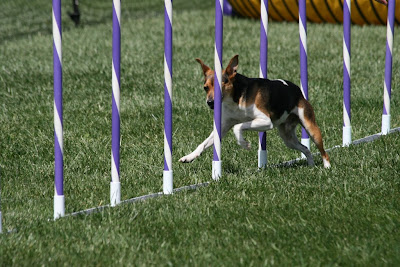
The dog must enter from the right side, i.e. with its left shoulder passing by the first pole. Then it must continue weaving left and right through each opening between the poles, similar to a skiing slalom.
Since the number of poles is always even, the dog should come out to the left side, i.e. with its right shoulder passing by the last pole.

The most common number of poles is 12. In AKC, Novice dogs have 6 poles to go through, and move on to 12 for Open and Excellent. In USDAA, there are 12 poles for all levels.
Training a dog to weave is a very slow process, and usually takes the longest of all. There are many methods designed to help the dog understand how it needs to move through the poles. Some of these are the Weave-O-Matic, the channel method, guide wires, brute force muscle memory, as well as the new and upcoming Two-By-Two method. Philip and I stated off with the muscle memory method at first, but quickly moved to the channel method when we changed instructors. I'll cover all of these in as much detail as I can in a future post, but in the end it really comes down to whatever works for you and your dog - each method has people that swear by it, and others that can't stand it.
There are many things that can go wrong with the Weaves - the dog isn't supposed to stop in the middle of weaving, and any wrong direction is counted as a refusal. If the dog weaves backwards several poles (usually 3 or 4), it will be counted as a wrong course. In AKC, refusals don't count on the Weaves at the Novice level, but a back weave will count as a wrong course, which automatically earns an NQ in JWW.
This post finally concludes the obstacle overview series. There are other obstacles in various organizations, but the ones I talked about are the most commonly used, and are the only ones seen in AKC and USDAA, which are the two organizations we compete in.
The Weaves are a set of 6 or 12 poles sticking straight up from the ground, about 20-22 inches apart.
The dog must enter from the right side, i.e. with its left shoulder passing by the first pole. Then it must continue weaving left and right through each opening between the poles, similar to a skiing slalom.
Since the number of poles is always even, the dog should come out to the left side, i.e. with its right shoulder passing by the last pole.
The most common number of poles is 12. In AKC, Novice dogs have 6 poles to go through, and move on to 12 for Open and Excellent. In USDAA, there are 12 poles for all levels.
Training a dog to weave is a very slow process, and usually takes the longest of all. There are many methods designed to help the dog understand how it needs to move through the poles. Some of these are the Weave-O-Matic, the channel method, guide wires, brute force muscle memory, as well as the new and upcoming Two-By-Two method. Philip and I stated off with the muscle memory method at first, but quickly moved to the channel method when we changed instructors. I'll cover all of these in as much detail as I can in a future post, but in the end it really comes down to whatever works for you and your dog - each method has people that swear by it, and others that can't stand it.
There are many things that can go wrong with the Weaves - the dog isn't supposed to stop in the middle of weaving, and any wrong direction is counted as a refusal. If the dog weaves backwards several poles (usually 3 or 4), it will be counted as a wrong course. In AKC, refusals don't count on the Weaves at the Novice level, but a back weave will count as a wrong course, which automatically earns an NQ in JWW.
This post finally concludes the obstacle overview series. There are other obstacles in various organizations, but the ones I talked about are the most commonly used, and are the only ones seen in AKC and USDAA, which are the two organizations we compete in.
Monday, May 10, 2010
Teeter Totter
The Teeter is a very scary obstacle for most dogs. It's a plank that rests over a swinging base in the middle
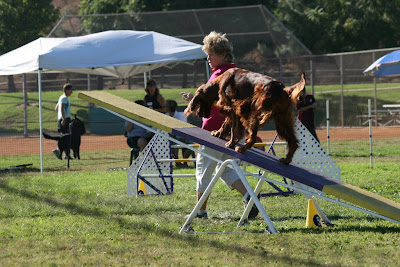
The dog has to run up on it from the side that's on the ground, cross over the center point causing it to tip, wait for the other other end to hit the ground, and then exit down the side that's now on the ground (opposite of starting end).
Like the other contact obstacle, the Teeter has a sandpaper-like surface, and also has the yellow contact zone on both ends. The dog has to touch the contact on both ends before entering/exiting the obstacle. The dog must also wait for the exit end to touch the ground at least once before exiting - it's okay to jump off while the teeter bounces back up, but not okay to jump off while it's descending for the first time.
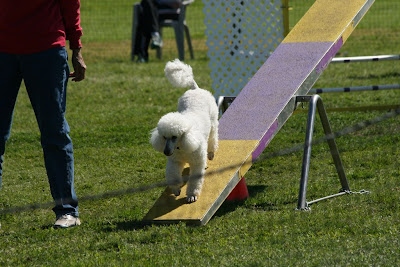
Most dogs are not very fond of falling to the ground together with the board and are often tempted to jump off to the side as they feel the board to begin moving. The banging sound of the board hitting the ground can be scary too.
The preferred performance is for the dog to run well past the center of the board, causing it to tip very quickly, and then exiting off the board. The problem with this though is that it causes the board to move fast and make a lot of noise, which is very scary. Hence, many dogs prefer slowly crawling to just the point where the board will gently slope to the other side, but that's a big waste of time.
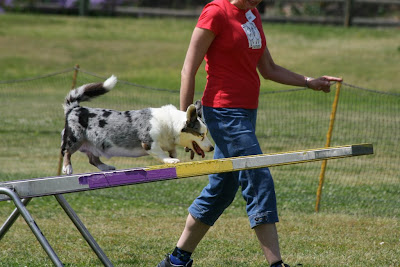
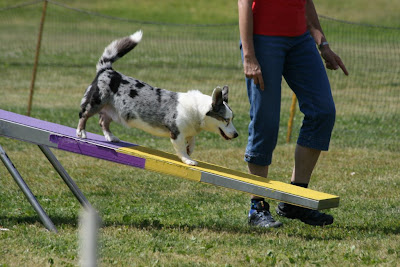
The first thing to do when teaching the Teeter is getting the dog used to the bang sound. Usually, you would hold the dog next to the Teeter, and move the board down with your hand, letting them see and hear it. Start off gently, and as the dog gets confident move up to slamming the board down as hard as you can (making sure you don't hit the dog of course). Once the dog gets used to the motion, it's time to get the dog on the board. It's best to start off by holding the Teeter motionless, letting the dog go up towards the high end, and slowly moving the board down as to not scare the dog. Even this exercise can prove to be very scary, but with lots of patience (and yummy treats), the dog should eventually learn to stay on. After that, it's just a matter of getting them to go on their own, letting go of the board earlier and earlier, until you no longer need to hold it at all. Keep in mind that you want the dog to go far up and get the board moving fast. The crawling method is best discouraged as it would be a very hard habit to break in the future.
Another thing to remember is that the bigger (and heavier) the dog is, the faster it will get the Teeter to move. Smaller dogs are at a disadvantage, but at least they tend to be a little braver of going farther up :)
The dog has to run up on it from the side that's on the ground, cross over the center point causing it to tip, wait for the other other end to hit the ground, and then exit down the side that's now on the ground (opposite of starting end).
Like the other contact obstacle, the Teeter has a sandpaper-like surface, and also has the yellow contact zone on both ends. The dog has to touch the contact on both ends before entering/exiting the obstacle. The dog must also wait for the exit end to touch the ground at least once before exiting - it's okay to jump off while the teeter bounces back up, but not okay to jump off while it's descending for the first time.
Most dogs are not very fond of falling to the ground together with the board and are often tempted to jump off to the side as they feel the board to begin moving. The banging sound of the board hitting the ground can be scary too.
The preferred performance is for the dog to run well past the center of the board, causing it to tip very quickly, and then exiting off the board. The problem with this though is that it causes the board to move fast and make a lot of noise, which is very scary. Hence, many dogs prefer slowly crawling to just the point where the board will gently slope to the other side, but that's a big waste of time.
The first thing to do when teaching the Teeter is getting the dog used to the bang sound. Usually, you would hold the dog next to the Teeter, and move the board down with your hand, letting them see and hear it. Start off gently, and as the dog gets confident move up to slamming the board down as hard as you can (making sure you don't hit the dog of course). Once the dog gets used to the motion, it's time to get the dog on the board. It's best to start off by holding the Teeter motionless, letting the dog go up towards the high end, and slowly moving the board down as to not scare the dog. Even this exercise can prove to be very scary, but with lots of patience (and yummy treats), the dog should eventually learn to stay on. After that, it's just a matter of getting them to go on their own, letting go of the board earlier and earlier, until you no longer need to hold it at all. Keep in mind that you want the dog to go far up and get the board moving fast. The crawling method is best discouraged as it would be a very hard habit to break in the future.
Another thing to remember is that the bigger (and heavier) the dog is, the faster it will get the Teeter to move. Smaller dogs are at a disadvantage, but at least they tend to be a little braver of going farther up :)
Wednesday, May 5, 2010
Contact Equipment
We are getting to the harder obstacles now :)
There are 3 different contact obstacles - A-Frame, Dog Walk, and Teeter Totter.
Today we'll look at the A-Frame and the Dog Walk. The Teeter is one of the hardest obstacles in Agility, so I'll dedicate a separate post to it later.
The A-Frame consists of two wide panels that are attached together to form a climbing obstacle that resembles the letter A (hence the name).
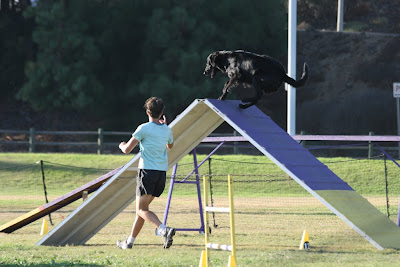
The panels are about 9 feet long each, and the top of the frame is 5 feet 6 inches from the ground - the picture above gives a good perspective of it.
The panels have a rough, non-slip (like sandpaper) surface, as well as small wooden slats going across the width to provide better footing.

The dog must climb up one side of the frame and descend down the other.
You can see that the panel is painted in two colors - the top color can vary, but the bottom part (lower 42 inches in AKC) is almost always yellow to indicate the contact zone. On the ascending side, this is usually called the "up contact", and on the descending side - "down contact". In order to clear the contact correctly, the dog must touch the yellow zone with at least one paw before going past it. In AKC, only the down contact is required for the A-Frame. In USDAA, the up contact needs to be touched as well. This is a safety measure to ensure that no dogs are leaping off of (or on to) the top of the A-Frame, as they could easily hurt themselves that way.
Touching the yellow can be okay with as little as a toenail (judge's call), and many handlers just hope their dogs will hit it on the way. It's hard to teach the up contact to a dog, but is usually only a problem for very leggy dogs. However, the down contact is very easy to be missed, even for very small dogs because they think they can fly!
Obviously, we can't explain to a dog that it much touch the yellow paint, so instead there are different tricks to get them to go to the bottom. Some handlers have their dog lay down at the bottom of the A-Frame, others slowly guide the dog down. In our class we use the "two on, two off" method - I'll cover it in more detail later, but basically it requires the dog to place two front feet on the ground while the two back feet are still resting on the panel.
Blowing the contact (i.e. not touching the yellow when required) is considered a failure to perform and will earn the dog an immediate NQ.
The Dog Walk is constructed of three wood panels (two ramps and a center section) that form a bridge-like obstacle (it's so long, it doesn't even fit in one picture!).

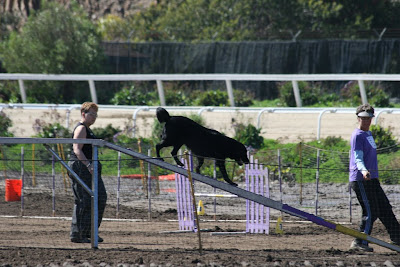
The ramps and center section are 12 feet long each, and the center section is 48 inches from the ground. The surface is the same as that on the A-Frame, and the ramps have similar slats for footing.
The Dog Walk also has contact zones, but unlike the A-Frame, both up and down contacts are required here. Normally, once a dog can perform the A-Frame correctly, it will pick up the Dog Walk quickly after that. The only extra thing to get used to at that point is the thin nature of the planks (they are only 12 inches wide), so some dogs need a little encouragement, as it can be scary, especially for the bigger guys.

There are 3 different contact obstacles - A-Frame, Dog Walk, and Teeter Totter.
Today we'll look at the A-Frame and the Dog Walk. The Teeter is one of the hardest obstacles in Agility, so I'll dedicate a separate post to it later.
The A-Frame consists of two wide panels that are attached together to form a climbing obstacle that resembles the letter A (hence the name).
The panels are about 9 feet long each, and the top of the frame is 5 feet 6 inches from the ground - the picture above gives a good perspective of it.
The panels have a rough, non-slip (like sandpaper) surface, as well as small wooden slats going across the width to provide better footing.
The dog must climb up one side of the frame and descend down the other.
You can see that the panel is painted in two colors - the top color can vary, but the bottom part (lower 42 inches in AKC) is almost always yellow to indicate the contact zone. On the ascending side, this is usually called the "up contact", and on the descending side - "down contact". In order to clear the contact correctly, the dog must touch the yellow zone with at least one paw before going past it. In AKC, only the down contact is required for the A-Frame. In USDAA, the up contact needs to be touched as well. This is a safety measure to ensure that no dogs are leaping off of (or on to) the top of the A-Frame, as they could easily hurt themselves that way.
Touching the yellow can be okay with as little as a toenail (judge's call), and many handlers just hope their dogs will hit it on the way. It's hard to teach the up contact to a dog, but is usually only a problem for very leggy dogs. However, the down contact is very easy to be missed, even for very small dogs because they think they can fly!
Obviously, we can't explain to a dog that it much touch the yellow paint, so instead there are different tricks to get them to go to the bottom. Some handlers have their dog lay down at the bottom of the A-Frame, others slowly guide the dog down. In our class we use the "two on, two off" method - I'll cover it in more detail later, but basically it requires the dog to place two front feet on the ground while the two back feet are still resting on the panel.
Blowing the contact (i.e. not touching the yellow when required) is considered a failure to perform and will earn the dog an immediate NQ.
The Dog Walk is constructed of three wood panels (two ramps and a center section) that form a bridge-like obstacle (it's so long, it doesn't even fit in one picture!).
The ramps and center section are 12 feet long each, and the center section is 48 inches from the ground. The surface is the same as that on the A-Frame, and the ramps have similar slats for footing.
The Dog Walk also has contact zones, but unlike the A-Frame, both up and down contacts are required here. Normally, once a dog can perform the A-Frame correctly, it will pick up the Dog Walk quickly after that. The only extra thing to get used to at that point is the thin nature of the planks (they are only 12 inches wide), so some dogs need a little encouragement, as it can be scary, especially for the bigger guys.
Subscribe to:
Posts (Atom)
